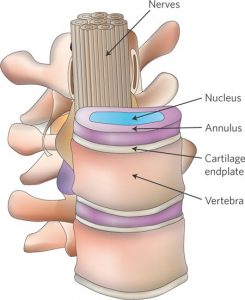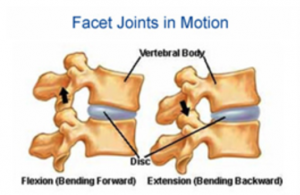by Dr. Troy Vander Molen, PT, DPT
As a physical therapist for twenty years, I have worked with a lot of people and a lot of diagnoses. I get a lot of questions from people in the community about their “rotary cup” or “slipped discs.” Even though those aren’t the correct terms, it’s easy to understand what the person is talking about, and it makes me think about how people perceive themselves, as well as how that impacts their health.
1. Slipped discs are a misnomer. It is one of the many myths about lower back problems. The phrase “slipped discs” gives people false ideas about what happens in their spines. So, let’s dispel those myths by reviewing some basics about the spine.

2. Discs are the spine’s structural design made up of flexible material that acts to cushion forces. A disc is positioned between each vertebra, directly in front of the spinal cord, which runs through a canal behind the vertebrae (Figure 1). The disc has rings that circle the perimeter, called the annulus fibrosus, that are made out of cartilage.
These cartilage rings number 15-25 total, and they surround the soft inner core, called the nucleus pulposus. The nucleus is 80% water content and is gel-like, particularly when we’re younger.
When we bend and move, which is exactly what the spine is designed to allow us to do, the discs dissipate forces between the vertebrae. When we load the spine during movement, the discs deform, slightly and temporarily, to allow for the movement to occur (Figure 2).

3. Over time, due to repeated mechanical pressure and tension, discs slowly wear out. This results in a loss of disc height and disc bulging, which is also referred to as disc prolapse or herniation. If there are some slight tears in the outer cartilage rings (annulus fibrosus), some of that inner gelatinous material (nucleus pulposus) may begin to slightly rupture through those openings, but that is much more likely to occur when we’re younger (under age 35), because as we age the nuclear material in the center loses water content and becomes less mobile.
4. A disc does not slide around, and it therefore can’t be manipulated back into position. So, the idea that the disc slips is really a myth. Yes, the inner disc material may bulge a little bit when we’re younger and the outer disc material may be displaced a bit when we’re older, but it is still stable in its position.
5. Most importantly, please note degenerative changes are absolutely normal. Recent studies show that up to 70% of us have disc bulges when viewed with MRI scans, and most do not have any symptoms. In other words, you are abnormal if you are an adult without degenerative disc issues. One study estimates that only 30% of people with disc degeneration experience any pain related to these changes.
So How Do I Know if I Have a Problem?
Well, I guess you could say that technically all of us have these problems. However, the problem doesn’t really need any attention unless you have pain and discomfort. At Kinetic Edge, we do not believe that everyone should seek treatment just because they have a spine that isn’t perfect.
It is often believed that “slipped discs” are the reason for leg pain or numbness. This leg pain or numbness, however, only occurs when the nerve that exits the spine and travels down the leg is receiving pressure. While changes to the disc may be the culprit, there are a variety of reasons that the nerve may be experiencing that pressure.
The single biggest mistake a person makes is to delay treatment when they begin to experience pain, whether the pain is local to the back or traveling down the leg. Usually these issues can be solved quickly and in a cost-effective way if we can assess and treat it early in the pain process. The goal is to find out the reason for the tissue pressure and resolve it, which will reduce inflammation and eliminate the pain.
The second biggest mistake a person makes is to stop moving. The importance of staying active cannot be underestimated. Moving ensures that muscles stay strong. It stimulates the nervous system and activates sensory nerves that block the pain signals. And it maintains the all-important mobility in spine joints.
There are some more significant symptoms of which you should be aware. If you have weakness in a leg muscle (i.e. can’t lift your foot or big toe) or difficulty controlling your bowel or bladder, you should contact your physical therapist or physician immediately. While these types of symptoms can occur, they are rare, and they are an indication that the pressure on a nerve is more significant.
Short of that, conservative care with a physical therapist is a highly effective way to mitigate back pain and restore proper motion throughout the kinetic chain. So, if you’re currently dealing with back pain or have experienced it in the recent past, we’d love to give you – at no cost or obligation – 20 minutes of our time to figure out the reason and solution for your pain. Once again, we have saved 10 slots in our schedule. Call now or email us to claim one before they are all taken up.



